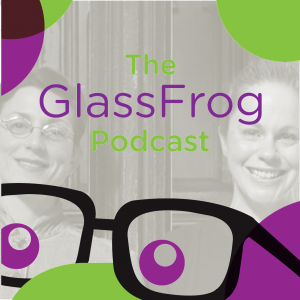Empathy in Evaluation
- Posted by GlassFrog
- On September 3, 2019
- 0

This week, Jen and Rebecca chat about the role that empathy can play in program evaluation. This chat was inspired by a workshop the Glass Frog team held internally a few months ago to discuss what empathy is, its importance for our work, and how we can become more empathetic as evaluators, consultants, and colleagues. We enjoyed that workshop and felt like it helped our team talk through some of the ways in which we are not always as empathetic as we could be. Having this conversation improved our work, so we thought y’all might find it useful as well!
As always, we appreciate you listening and would love to hear your thoughts! Feel free to ping us on the Contact Us page with your questions and thoughts!
A few resources if you want to keep digging in…
We are not experts on empathy, merely eager practitioners. We’re passing along some resources we’ve consulted, but, as is always the case, this is a nuanced topic supported by decades and decades of research. We don’t purport to even scratch the surface of this research, but hope that you will find these resources helpful as you get started. If you think there are other resources we should check out, we’d love to hear about them!
General resources (some referenced in the podcast)
If I Understood You, Would I Have This Look on My Face? by Alan Alda
Clear+Vivid with Alan Alda (Alda’s podcast)
“Cognitive and Emotional Empathy in Typically Developing Children: The Influence of Age, Gender, and Intelligence,” by Christina Schwenck and colleagues, European Journal of Developmental Psychology AND “The Empathy Quotient: An Investigation of Adults with Asperger Syndrome or High Functioning Autism, and Normal Sex Differences,” by Simon Baron-Cohen and Sally Wheelwright, Journal of Autism and Developmental Disorders. (These articles will help give you an introduction to the academic literature on cognitive and emotional empathy.)
“There Are Actually 3 Types of Empathy. Here’s How They Differ–and How You Can Develop Them All,” by Justin Bariso. (Bariso also has a book called EQ Applied: The Real-World Guide to Emotional Intelligence, which neither of us has read, but you should read it and let us know how it is.)
The Center for Creative Leadership has a white paper on the value of empathy in the workplace: Empathy in the Workplace: A Tool for Effective Leadership.
On taking steps to become more empathetic evaluators:
See Chapters 12 and 15 of the Alda book.
“The Science of Scientific Writing” by George D. Gopen and Judith A. Swan. (This article was referenced by Alda as well.)
Edward Tufte’s work is useful for putting yourself in the shoes of the folks who will be consuming your graphs and visualizations. This is a one-page excerpt from his book The Visual Display of Quantitative Information, Version 2, though we recommend the full book!
On the “dark side” of empathy:
Against Empathy by Paul Bloom
Bloom also has an article in The Atlantic called “The Dark Side of Empathy,” which gives an overview of some of his ideas.
(Alda’s book also has a chapter on this called “Dark Empathy” (Chapter 14).)
Sponsors! This episode is brought to you by Jen and Rebecca’s daily walks. Boy do we enjoy a nice, healthy walk. Jen’s pace can be described as brisk, with long strides culminating in a light, glowing perspiration. Rebecca’s pace can be described as a lumbering trudge that is useful for clearing one’s head but so sluggish as to be unsuitable for getting from Point A to Point B. Jen often walks with her dog, Sammy. Rebecca most often walks alone. Jen and Rebecca rarely take their walks together, but when they do, it’s magic. The best part about the daily walk is … wait for it … it’s free! Thank you, daily walk, for supporting the Glass Frog Podcast!

